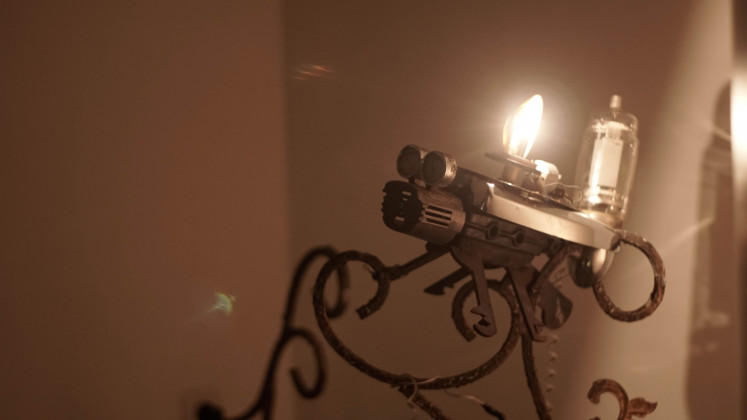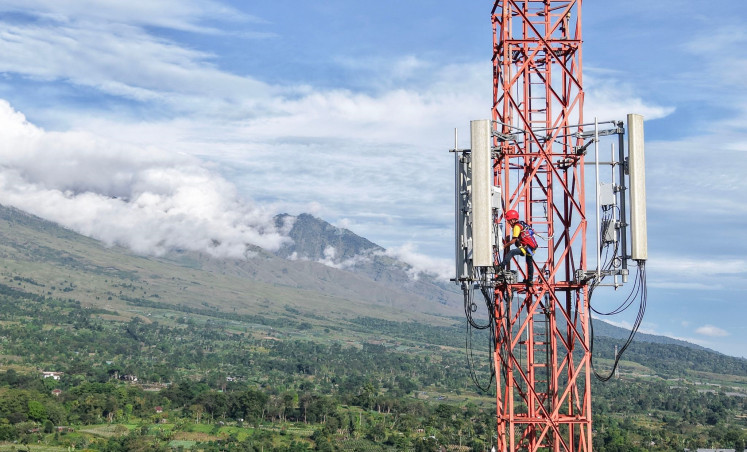Popular Reads
Top Results
Can't find what you're looking for?
View all search resultsPopular Reads
Top Results
Can't find what you're looking for?
View all search resultsLooking far ahead: Artist uses robotic insects as mementos for future generations
Using robotic fireflies, an artist portrays the Earth in its most collapsing form.
Change text size
Gift Premium Articles
to Anyone
W
earing only a T-shirt and shorts, the installation artist known as Toyol was busy fiddling with a robot he had created and called "Fireflies", when The Jakarta Post met him at a new gallery called Nol Kecil in Surabaya, on June 15.
"Having a bit of a problem here. The wheels and gears are a little stuck," said Toyol, real name Abdul Khafidz Fadli, 25 years of age. He was preparing to open his first solo exhibition entitled Quantum Fayyakun. "Not only that, I'm a little nervous too, so I'm checking them all again and making sure things are okay.”
At the exhibition, Toyol plans to exhibit his fireflies cyborg. He collected a mixture of used goods, such as motorbikes, satellite dishes, fences, scrap metal and obsolete knick-knacks that he had found at flea markets, and assembled them through what some artists call a process of “cannibalizing”. Toyol's work as an artist always screams "experimental", a term he accepts. Before concentrating on installation art, Toyol first started his experiments with sounds. He had joined the “noise music” collective, Melawan Kebisingan Kota (roughly translated as "against city noise"), which exhibited their sound creations at the Jakarta Biennale in 2015.
Reconstructing fireflies
The sound of metal clashing together echoed within the showroom, a rhythmic, synchronized noise. In the dark, a dim glow of what looked like an eye appeared from the mysterious creations that occupied every corner of the room. The scattered brown soils were illuminated by the yellow light, revealing the mysterious side of the showroom. And with that, various lights and sounds emerged from Toyol’s fireflies.
"This is my vision of what fireflies would be like in the future. I've often thought to myself, because of such massive [infrastructure] developments and humans being too noisy, the fireflies would be extinct in no time,” shared Toyol.
Light up the dark: Toyol remodeled an old motorcycle carcass for the body, and used parabolic remnants to make firefly wings. (JP/Reno Surya)The inspiration was a personal one.
“I felt it firsthand. In the past, it was easy to find fireflies in the area where I lived, the outskirts of Surabaya, which wasn't so noisy. But now, I rarely see them. I need to retreat to somewhere rural to see them. I think this is the aftermath of the destructive nature of humans today, and creatures like fireflies no longer have space now," he said.
He said, someday when the fireflies were eventually extinct, the insect would seem like a “myth” to humans. Toyol envisioned that later there would be scientists or people who would try to disprove the myth and revive the fireflies. He hopes that the objects he exhibits today can be used as data references for people in the future. After the exhibition ended, he buried more than 20 fireflies and scattered them in various places.
Toyol imagined that in the future, the world would be made of iron. Therefore, he deliberately chose metal as the primary material for his work. Because it has gone through a long evolutionary process, the appearance of fireflies in the future will look unusual.
"People today would see that as an anomaly. But that's the future. That is the face of the future," explained Toyol.
For Toyol, fireflies are extraordinary animals. This is because the animal undergoes three metamorphic phases. And the three phases represent the elements of life: water, earth and air. First, before appearing as a beautiful creature, the firefly is a larva floating in the water. After that, it becomes a caterpillar. After passing through the stage of being an "ugly" creature, it will grow into a beautiful creature shining in the dark of night at the end of its life.
"It's almost like a butterfly. But even though the butterfly is an animal that has beautiful wings, it does not carry light. In the future, when the world is swallowed up in long darkness when disaster destroys all electrical arrangements and lights go out, fireflies will be the only source of light. A ray of light in a world so dark."
As a way of preparing for his mission to entrust the fireflies to future generations, Toyol plans to put his robot into an iron capsule after the exhibition. Inside the capsule, there is also a document on how to activate the work. Hopefully, it will be a small token of the past that he can leave for his children and grandchildren.
"In the auction, anyone can buy the work. But the buyer is not given the right to own it completely. They must be ready when the time comes. I will ask for the work to be returned to its origin. I'm planning to bury it in the seabed, underground, and in other hidden places."
Unraveling myths
Toyol works as a welder in his private workshops, located in Nongkojajar, Malang and throughout Surabaya. In his process of creation, Toyol usually searches for Javanese serat (manuscripts) and studies the holy Quran. His work, entitled Quantum Fayyakun, is utterly different from his previous work, which often depicts mysticism and occultism. In this exhibition, mysticism is shown subtly, and he recently has been busy exploring the "future world".
For example, at the East Java Beinalle 2017 event, Toyol created an installation that presented a collection of Javanese ghosts. He scrambled a pentagram in the center of what was a charity box. Among the pentagrams, he installed imaginary demons named DJ Jelangkung, Anjing Jahat (Evil Dog), Pocong Krueget, and Adik Toyol (Little Toyol). In a dark square room, a prayer is slowly chanted. When the audience approaches, one by one, the demons created by Toyol will move, scream, and not infrequently, frighten visitors.
"Right now, I'm not strong enough to make works like those again. Because my previous work took a lot of effort. I had to perform rituals and make offerings. Now I want to do something that deals with the future first. One day, I want to make something dark again," he said.
Ayos Purwoaji, an independent art curator who has been observing Toyol's works from several years ago, said that even in his most recent exhibition, Toyol had not gotten over his "Junky" [rombeng] aesthetic.
"Even though he tries to tidy up his work and make it sweeter, the 'junky' aesthetic is still very thick. If you observe it, Melawan Kebisingan Kota, WAFT Lab, his early exhibition, and his noise projects, none of it can be separated from what we can call 'junkiness.'" Ayos told the Post. "Toyol's forte is to transform junk into art, wrapped with pseudo-science, mysticism and Islamic-Javanese narrative, he could even process the work ethics of factory workers in Sepanjang, his birthplace, into a work of art."













